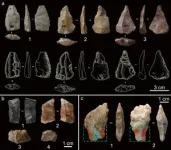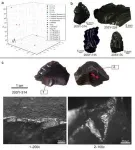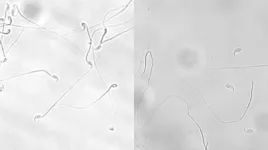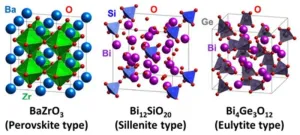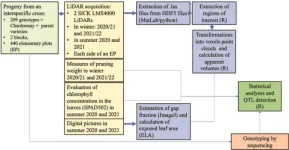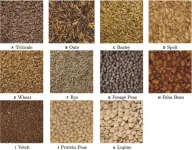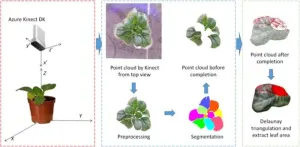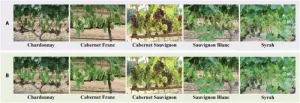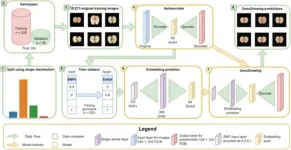(Press-News.org) The European Society of Endocrinology (ESE) is pleased to announce that the new Editor-in-Chief of our flagship journal, the European Journal of Endocrinology (EJE), is Professor Felix Beuschlein, M.D. He will assume his post in May 2024 when the current Editor in Chief, Professor Wiebke Arlt, steps down.
Professor Philippe Chanson, Chair of ESE’s Publications and Communications Committee said, “I am delighted that Felix will be the next Editor in Chief of ESE’s flagship journal and will continue to build on the strong foundations laid by his predecessors. Felix’s internationally recognised work, his large network and his collaborative and thorough approach to research means EJE is in good hands.”
Felix Beuschlein is Professor of Internal Medicine/Endocrinology and Director of the Clinic for Endocrinology, Diabetology and Clinical Nutrition at the University Hospital Zurich in Switzerland. He received his medical degree from the School of Medicine at the University of Würzburg and completed his medical training in Freiburg, both in Germany. For postdoctoral studies he joined the University of Michigan in Ann Arbor. Following a professorship for Endocrine Research at the University of Munich in 2017, he was recently elected for a chair position at the University of Zurich. He was recently (November 2023) awarded the ‘Transatlantic Alliance Award’ by ESE and the Endocrine Society which recognises an international leader who has made significant advancements in endocrine research on both sides of the Atlantic - in Europe and the United States.
Felix said, “I am thrilled and honoured to take on this position within the EJE team to continue on a development of the journal towards its leading position reflecting clinical and translation endocrinology at large.”
Wiebke Arlt (Director of the MRC Laboratory of Medical Sciences (LMS) and Professor of Transdisciplinary Medicine, Imperial College London, UK) has been Editor-in-Chief since January 2019, when she succeeded Professor Hans Romijn. Since then, she has taken the journal to its highest ever Impact Factor of 6.664 (June 2021) and number 20 out of 145 in the JCR list of Endocrinology and Metabolism research journals in terms of Impact Factor, underpinning the leading role of ESE in fostering exchange and scientific discourse and promoting endocrinology. She has built a strong and diverse Editorial Board with gender parity. Wiebke has also introduced the ‘EJE Rising Stars’ in 2022, fostering and developing editorial board members of the future. The second EJE Rising Stars cohort will be announced shortly. Wiebke was elected as ESE’s President Elect in May 2023 and will assume the role of ESE President in May 2025 when the current President Jérôme Bertherat steps down.
She commented, “Felix Beuschlein is an internationally leading endocrinologist with a track record of collaboration and innovation. I am looking forward to working with him over the transition period in the coming months and I am delighted that EJE will continue to be in very safe hands.”
Professor Jérôme Bertherat, President of ESE, added, “On behalf of ESE’s members I am pleased to have such an excellent successor to our current Editor in Chief Wiebke Arlt to take the Journal into the next phase of its development. The ESE Executive Committee and I look forward to working with him over the years ahead.
END
Felix Beuschlein announced as new Editor-in-Chief of the European Journal of Endocrinology
The European Society of Endocrinology (ESE) is pleased to announce that the new Editor-in-Chief of our flagship journal, the European Journal of Endocrinology (EJE), is Professor Felix Beuschlein, M.D.
2024-01-18
ELSE PRESS RELEASES FROM THIS DATE:
Missing gene could explain infertility
2024-01-18
Mice lacking a certain gene are unable to produce offspring because their sperm lack the connection between the tail and the head. A new thesis from the University of Gothenburg indicates a probable cause of male infertility.
Researchers at the University of Gothenburg have identified a new protein, dubbed by them as “MC2”, that plays a crucial part in the formation of swimmable sperm in mice. This protein is needed to create a functional connection between the head and the tail of the sperm.
“The connection is located in the ‘neck’ of the sperm head and facilitates coordinated movement and function ...
Scientists uncover new marine source of carbon emissions into atmosphere, finding bottom trawling contributes to global warming
2024-01-18
(WASHINGTON, DC) 18 JANUARY 2024 — Bottom trawling is a previously unaccounted for source of atmospheric carbon emissions, scientists reveal in a study published today. As the world scrambles to slash emissions caused by fossil fuels, deforestation and other sources, the study finds bottom trawling — the act of dragging a heavy fishing net across the ocean floor and resuspending some of the carbon in the seafloor sediment — to be a significant source of atmospheric carbon pollution. A previous study found that part of that disturbed ...
Light it up: reimagining the optical diode effect
2024-01-18
Osaka, Japan – At the heart of global internet connectivity, optical communications form an indispensable foundation. Key to this foundation are optical isolators, created by combining multiple components. The result is a complex structure that transmits light in only one direction, to prevent damage to lasers and minimize noise by avoiding the reversal of light. However, some magnetic materials have an optical diode effect – an unconventional nonreciprocal absorption of light manifested by the material itself. This effect leads to a change in transmittance depending ...
Machine learning method speeds up discovery of green energy materials
2024-01-18
Fukuoka, Japan – Researchers at Kyushu University, in collaboration with Osaka University and the Fine Ceramics Center, have developed a framework that uses machine learning to speed up the discovery of materials for green energy technology. Using the new approach, the researchers identified and successfully synthesized two new candidate materials for use in solid oxide fuel cells – devices that can generate energy using fuels like hydrogen, which don’t emit carbon dioxide. Their findings, which were reported in the journal, ...
Revolutionizing grapevine phenotyping: harnessing LiDAR for enhanced growth assessment and genetic insights
2024-01-18
In response to the pressing need to reduce pesticide usage and adapt grapevine varieties to climate change, there's an unprecedented effort to phenotype new genotypes using high-throughput methods. Teams globally are developing advanced systems, employing technologies like multispectral cameras and LiDAR, to assess growth traits, photosynthetic capability, and other architectural parameters. However, traditional methods remain time-consuming and less efficient for large-scale studies. The current research gap lies in effectively employing LiDAR technology ...
AI-driven nutritional assessment of seed mixtures enhances sustainable farming practices
2024-01-18
Cultivating seed mixtures for local pastures is an age-old method to produce cost-effective and balanced animal feed, enhancing agricultural autonomy and environmental friendliness in line with evolving European regulations and organic consumer demands. Despite its benefits, farmers face adoption challenges due to the asynchronous ripening of cereals and legumes and the difficulty in assessing the nutritional value of heterogeneous seeds. Current practices rely on informal, empirical methods, and a proposed solution is to develop a mobile app or online service, similar to Pl@ntNet, for automated nutritional evaluation of seed mixtures, ...
Revolutionizing plant phenotyping: deep learning and 3D point cloud technology in overcoming reconstruction challenges
2024-01-18
The 3-dimensional point cloud technology revolutionizes non-invasive measurement of plant phenotypic parameters, offering vital data for agriculture and research. Current research focuses on overcoming the limitations of 2.5D imaging and occlusions. Methods such as structure from motion, multi-view stereo, and advanced active 3D reconstruction techniques are being explored for this purpose. However, issues persist with incomplete data acquisition and the inaccuracy of phenotypic parameter extraction due ...
Revolutionizing grape yield predictions: the rise of semi-supervised berry counting with CDMENet
2024-01-18
To improve grape yield predictions, automated berry counting has emerged as a crucial yet challenging task due to the dense distribution and occlusion of berries. While grape cultivation is a significant global economic activity, traditional manual counting methods are inaccurate and inefficient. Recent research has shifted towards deep learning and computer vision, employing detection and density estimation techniques for more precise counts. However, these methods grapple with the variability of farmland and high occlusion rates, leading to significant counting errors. Additionally, creating high-performance ...
GenoDrawing: pioneering plant phenotyping with autoencoders and SNP markers
2024-01-18
Advancements in whole-genome sequencing have revolutionized plant species characterization, providing a wealth of genotypic data for analysis. The combination of genomic selection and neural networks, especially deep learning and autoencoders, has emerged as a promising method for predicting complex traits from this data. Despite the success in applications like plant phenotyping, challenges remain in accurately translating visual information from images into measurable data for genomic studies.
In November 2023, Plant ...
USC Office of Research and Innovation names new executive director for USC Stevens Center
2024-01-18
Erin Overstreet has been selected as the new executive director of the USC Stevens Center for Innovation where she will oversee the university’s commercialization of USC-driven intellectual property.
Overstreet’s expertise and experience embody technology transfer and innovation across the academic, educational, and venture capital sectors; such experience is critical for bridging USC research to a broadened, national technology transfer ecosystem, said Ishwar Puri, senior vice president of the Office of Research and Innovation.
“The university has the utmost confidence in Dr. Overstreet’s ability to ...
LAST 30 PRESS RELEASES:
Longest observation of an active solar region
Why nail-biting, procrastination and other self-sabotaging behaviors are rooted in survival instincts
Regional variations in mechanical properties of porcine leptomeninges
Artificial empathy in therapy and healthcare: advancements in interpersonal interaction technologies
Why some brains switch gears more efficiently than others
UVA’s Jundong Li wins ICDM’S 2025 Tao Li Award for data mining, machine learning
UVA’s low-power, high-performance computer power player Mircea Stan earns National Academy of Inventors fellowship
Not playing by the rules: USU researcher explores filamentous algae dynamics in rivers
Do our body clocks influence our risk of dementia?
Anthropologists offer new evidence of bipedalism in long-debated fossil discovery
Safer receipt paper from wood
Dosage-sensitive genes suggest no whole-genome duplications in ancestral angiosperm
First ancient human herpesvirus genomes document their deep history with humans
Why Some Bacteria Survive Antibiotics and How to Stop Them - New study reveals that bacteria can survive antibiotic treatment through two fundamentally different “shutdown modes”
UCLA study links scar healing to dangerous placenta condition
CHANGE-seq-BE finds off-target changes in the genome from base editors
The Journal of Nuclear Medicine Ahead-of-Print Tip Sheet: January 2, 2026
Delayed or absent first dose of measles, mumps, and rubella vaccination
Trends in US preterm birth rates by household income and race and ethnicity
Study identifies potential biomarker linked to progression and brain inflammation in multiple sclerosis
Many mothers in Norway do not show up for postnatal check-ups
Researchers want to find out why quick clay is so unstable
Superradiant spins show teamwork at the quantum scale
Cleveland Clinic Research links tumor bacteria to immunotherapy resistance in head and neck cancer
First Editorial of 2026: Resisting AI slop
Joint ground- and space-based observations reveal Saturn-mass rogue planet
Inheritable genetic variant offers protection against blood cancer risk and progression
Pigs settled Pacific islands alongside early human voyagers
A Coral reef’s daily pulse reshapes microbes in surrounding waters
EAST Tokamak experiments exceed plasma density limit, offering new approach to fusion ignition
[Press-News.org] Felix Beuschlein announced as new Editor-in-Chief of the European Journal of EndocrinologyThe European Society of Endocrinology (ESE) is pleased to announce that the new Editor-in-Chief of our flagship journal, the European Journal of Endocrinology (EJE), is Professor Felix Beuschlein, M.D.

